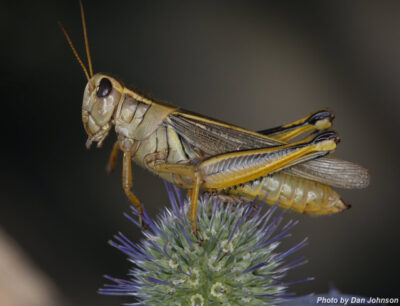Committee analyzes potential for grasshopper infestation
By Al Beeber - Lethbridge Herald on June 9, 2022.
 Photo by Dan Johnson
An adult female two-striped grasshopper, which invaded an area of the city's westside last year, perches on a flower.
Photo by Dan Johnson
An adult female two-striped grasshopper, which invaded an area of the city's westside last year, perches on a flower.LETHBRIDGE HERALDabeeber@lethbridgeherald.com
Barbara Learn experienced first-hand the grasshopper infestation that became the scourge of some areas of Lethbridge last summer.
The resident of Sunridge on the westside told the Civic Works Standing Policy Committee of city council Wednesday grasshoppers decimated her yard, devouring everything they could including grass down to the roots, and about 40 per cent of the damage is permanent.
Thousands of grasshoppers would jump on family members when they ventured outdoors, Learn recalled to the SPC which consists of chair and acting mayor Belinda Crowson, vice-chair and councillor Nick Paladino and councillors John Middleton-Hope and Ryan Parker.
But 2022 could be an improvement, the SPC was told by Dan Johnson, a University of Lethbridge professor of Environmental Science who is president of the Entomological Society of Alberta and holds a Ph.D. in Predator-Prey Ecology and Biological Control from the University of British Columbia, who is working with the city’s Parks & Cemeteries department on a mitigation plan.
Johnson does research in biogeography, environmentally sustainable agriculture, entomology, biodiversity rational pest management, biological control, ecology, insect movement and other matters.
He is also principal investigator and national coordinator of the Canadian Zebra Chip and Potato Psyllid Monitoring Network and before coming to the U of L was a senior research scientist with Agriculture Canada and Agri-Food Canada.
“This is kind of a special case because normally in an agriculture situation you have many species of grasshopper, some of which are attacking the crop and rangeland. This is only one species that built up in the crop there and roadsides and that one species benefitted from the hot weather last summer, an unprecedented hot July and that boosted them after two years of warmth and then they came charging in when there was nothing to eat,” Johnson told the SPC.
“So they move when there’s nothing to eat and they increase in size and number when they have heat so they had a perfect storm. It might not be as bad again this year,” said Johnson.
The City has a plan to test some non-toxic methods that may or may not work, said Johnson. They and Johnson feel insecticides should be kept away from the city, he told SPC.
“One of the problems with grasshoppers is you can’t monitor everywhere all the time,” Johnson said, adding the technology and personnel don’t exist to monitor every part of the county.
But he said it would be an idea for the next couple of summers to do survey and mapping occasionally in areas.
“If we have another hot summer or two, now that these insects of one generation year are where they are now, they could move up. They can’t come from nothing,” he said. With drought and another hot summer, they could return.
Johnson said when a field is fallow or allowed to dry down for harvest, the grasshoppers move out to fresh grass and if the grass isn’t their preferred food or they run out of alfalfa they will move into yards which happened last year, he said.
The two-striped grasshopper (Melanoplus bivittatus) doesn’t fly much but rather walks and built up in roadsides and then the heat brought them out, Johnson said, adding other areas including Skiff, Raymond and Carmangay also had problems.
Mitigating factors to a worsening situation include more of a fungal disease that attacks grasshoppers after rain last year. He said that infection of entomophagy grylli was worse than he’d seen in 20 or 30 years, which was a good thing, Johnson added, and cut back numbers by about half.
Monitoring has shown that they’re up to the middle of the immature stage and there are no large grasshoppers yet.
If the weather stays hot, numbers could increase again. The recent rain has held them back by about 10 per cent but has held them at the stage they’re at now because grasshoppers are cold-blooded and can’t grow.
“It won’t be as bad as last year but if it’s hot in July they could be back,” Johnson said.
A City management plan includes the opportunity to create test plots and implement control measures to evaluate the effectiveness of a chosen control program. These plots will include measures such as diatomaceous earth, targeted water and applications of vegetable oil.
In response to a question from Crowson, Johnson said tiny immature grasshoppers are harmed by fungus and mud and other things. Numbers will often be cut in half by rain at this time of year, he said, calling the recent downpours perfectly timed.
Rain later in the summer will encourage fungi that attacks the adults and they will lay fewer eggs, he said.
“I think monitoring is the way to go and the City is doing the proper thing.”
The City is also working to mitigate foxtail issues. The city is continuing with pre-emergent spraying this summer and will do regular spraying through the season. Pre-emergent spraying will also be done this fall. Residents are encouraged to avoid areas with foxtail to keep pets safe.
In 2021, with reduced mowing and staff numbers, drought left areas of high salinity exposed, allowing for seed germination. With no spraying of medians, this allowed for seed germination in areas that usually would have been managed by herbicide, says a City report.
Last fall, Parks & Cemeteries did pre-emergent spraying at 98 locations in the city. This year, an additional seven labourers have been hired to help with mowing and trimming while another 12 labourers have been hired to work on shrubs. There are also two additional chemical applicators.
Follow @albeebHerald on Twitter
4-3


